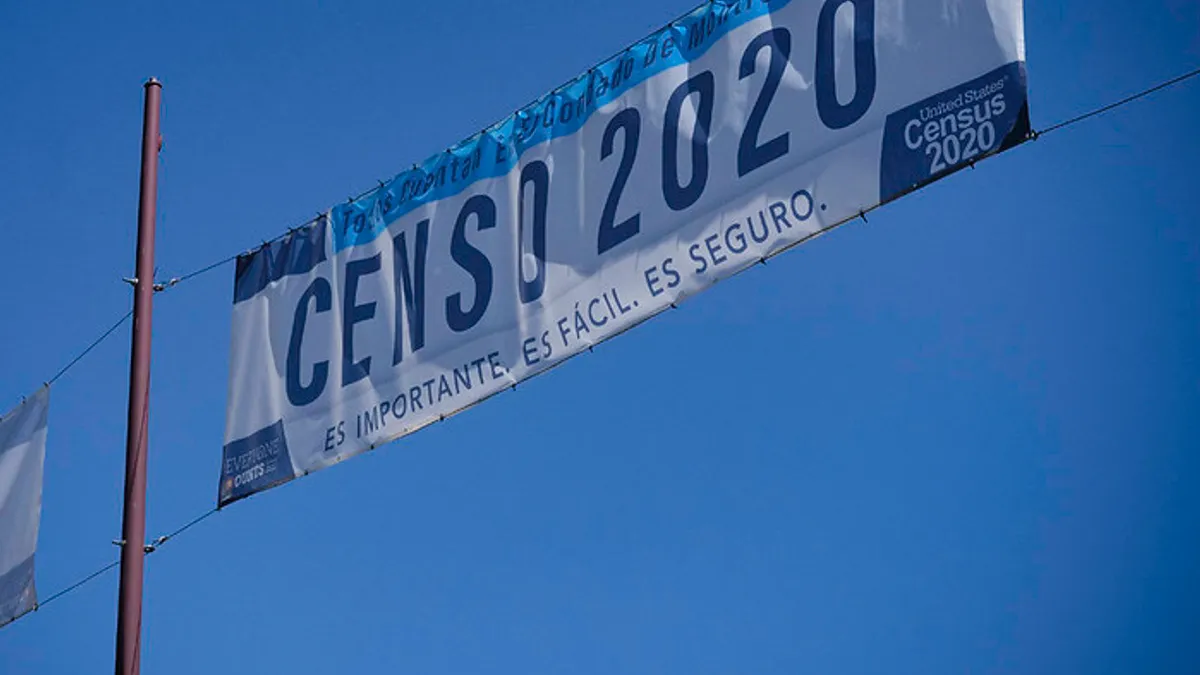Dive Brief:
- Fintech company SmartAsset released a new study of 2020 Census self-response rates in U.S. cities and states, as of May 4. Of the 50 largest U.S. cities, those with the highest and lowest self-response rates are as follows:
| Highest self-response rates | |
| Louisville, KY | 68.0% |
| Seattle | 66.8% |
| San Jose, CA | 65.4% |
| Colorado Springs, CO | 64.9% |
| Minneapolis | 64.8% |
| Lowest self-response rates | |
| Baltimore | 46.6% |
| New York | 45.4% |
| Philadelphia | 45.1% |
| Detroit | 43.0% |
| Miami | 42.1% |
- The cities with the highest self-response rates represent geographical diversity, with the top-10 list including two Midwestern cities, six Western cities and two Southern cities. Northeastern cities fell behind in the ranking, with Boston, New York City and Philadelphia all falling in the bottom 10.
- On a state level, Michigan, Wisconsin, Iowa and Nebraska lead the U.S. in census response, each with response rates of more than 63%. Those four states also led the way in 2000 and 2010.
Dive Insight:
The nation's current self-response rate sits at 59.1%, according to May 14 data from the U.S. Census 2020 website. April 1 is the reference date for residents to self-respond to the census, yet the novel coronavirus (COVID-19) pandemic has thrown a wrench in outreach plans, like field operations.
Earlier this month, U.S. Secretary of Commerce Wilbur Ross and U.S. Census Bureau Director Steven Dillingham urged Congress to grant an extension for self-responses to Oct. 31, which was later implemented and shared on the 2020 Census schedule of operations. Nonresponse Followup (NRFU) has also been extended to Oct. 31, while final counts will not be due to the president until April 30, 2021.
To analyze self-response rates on a state and city level, SmartAsset compared data from the 2010 Census to this year's count, while also analyzing the 2020 self-response rates. They found the coronavirus has played a significant role in response rates, compared with 2010, yet the introduction of online responses has aided efforts to get out the count.
More than seven out of 10 households have responded so far online nationwide, SmartAsset found, with the exception of households in Arkansas and Mississippi.
Yet, this year's online capabilities have also brought to light the digital divide that many cities still face — which is further amplified by pandemic complications in some areas. SmartAsset found the highest rates of self-responses online in Austin, TX; Seattle; Raleigh, NC; Virginia Beach, VA; and Arlington, TX.
Meanwhile, Miami; Fresno, CA; Baltimore; Memphis, TN and Detroit sit at the bottom of the list.
The digital divide is a constant struggle in a city like Detroit, where many homes lack internet access due to high poverty levels. The Associated Press predicted the count would be a challenge in Detroit back in 2019, noting that in 2000 and 2010, the overall census response rates were 70% and 64%, respectively.
To ensure the 2020 census sees near-perfect count rates, many governments and partners have gotten creative in messaging strategies. Libraries have stepped up as census resources amid the pandemic, providing Wi-Fi and information for in-need Americans, while many cities have ramped up use of social media platforms — even TikTok — to communicate the importance of the count.
CLARIFICATION: This story has been updated to clarify the significance of April 1, which is a reference date for census respondents to use when answering the census questionnaire.













